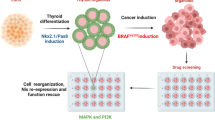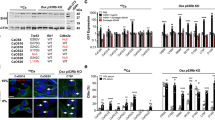Abstract
Papillary thyroid carcinomas are characterized by rearrangements of the RET receptor tyrosine kinase generating RET/PTC oncogenes. Here we show that osteopontin (OPN), a secreted glycoprotein, is a major RET/PTC-induced transcriptional target in PC Cl 3 thyroid follicular cells. OPN upregulation depended on the integrity of the RET/PTC kinase and tyrosines Y1015 and Y1062, two major RET/PTC autophosphorylation sites. RET/PTC also induced a strong overexpression of CD44, a cell surface signalling receptor for OPN. Upregulation of CD44 was dependent on RET/PTC Y1062, as well. Constitutive OPN overexpression or treatment with exogenous recombinant OPN sharply increased proliferation, Matrigel invasion and spreading in collagen gels of RET/PTC-transformed PC Cl 3 cells. These effects were impaired by the treatment of PC Cl 3-RET/PTC cells with OPN- and CD44-locking antibodies. Thus, RET/PTC signalling triggers an autocrine loop involving OPN and CD44 that sustains proliferation and invasion of transfomed PC Cl 3 thyrocytes.
This is a preview of subscription content, access via your institution
Access options
Subscribe to this journal
Receive 50 print issues and online access
$259.00 per year
only $5.18 per issue
Buy this article
- Purchase on Springer Link
- Instant access to full article PDF
Prices may be subject to local taxes which are calculated during checkout







Similar content being viewed by others
References
Andreozzi F, Melillo RM, Carlomagno F, Oriente F, Miele C, Fiory F, Santopietro S, Castellone MD, Beguinot F, Santoro M and Formisano P . (2003). Oncogene, 22, 2942–2949.
Asai N, Murakami H, Iwashita T and Takahashi M . (1996). J. Biol. Chem., 271, 17644–17649.
Ashkar S, Weber GF, Panoutsakopoulou V, Sanchirico ME, Jansson M, Zawaideh S, Rittling SR, Denhardt DT, Glimcher MJ and Cantor H . (2000). Science, 287, 860–864.
Bartolazzi A, Gasbarri A, Papotti M, Bussolati G, Lucante T, Khan A, Inohara H, Marandino F, Orlandi F, Nardi F, Vecchione A, Tecce R and Larsson O . (2001). Lancet, 357, 1644–1650.
Basolo F, Giannini R, Toniolo A, Casalone R, Nikiforova M, Pacini F, Elisei R, Miccoli P, Berti P, Faviana P, Fiore L, Monaco C, Pierantoni GM, Fedele M, Nikiforov YE, Santoro M and Fusco A . (2002). Int. J. Cancer, 97, 608–614.
Borrello MG, Alberti L, Arighi E, Bongarzone I, Battistini C, Bardelli A, Pasini B, Piutti C, Rizzetti MG, Mondellini P, Radice MT and Pierotti MA . (1996). Mol. Cell. Biol., 16, 2151–2163.
Buckwalter TL, Venkateswaran A, Lavender M, La Perle KM, Cho JY, Robinson ML and Jhiang SM . (2002). Oncogene, 21, 8166–8172.
Carlomagno F, Vitagliano D, Guida T, Ciardiello F, Tortora G, Vecchio G, Ryan AJ, Fontanini G, Fusco A and Santoro M . (2002). Cancer Res., 62, 7284–7290.
Castellone MD, Cirafici AM, De Vita G, De Falco V, Malorni L, Tallini G, Fagin JA, Fusco A, Melillo RM and Santoro M . (2003). Oncogene, 22, 246–255.
Chabas D, Baranzini SE, Mitchell D, Bernard CC, Rittling SR, Denhardt DT, Sobel RA, Lock C, Karpuj M, Pedotti R, Heller R, Oksenberg JR and Steinman L . (2001). Science, 294, 1731–1735.
Chang PL and Prince CW . (1993). Cancer Res., 53, 2217–2220.
Curcio F, Ambesi-Impiombato FS, Perrella G and Coon HG . (1994). Proc. Natl. Acad. Sci. USA, 91, 9004–9008.
Ermak G, Gerasimov G, Troshina K, Jennings T, Robinson L, Ross JS and Figge J . (1995). Cancer Res., 55, 4594–4598.
Fagin JA . (2002). Endocrinology, 143, 2025–2028.
Fusco A, Berlingieri MT, Di Fiore PP, Portella G, Grieco M and Vecchio G . (1987). Mol. Cell. Biol., 7, 3365–3370.
Guo X, Zhang YP, Mitchell DA, Denhardt DT and Chambers AF . (1995). Mol. Cell. Biol., 15, 476–487.
Hayashi H, Ichihara M, Iwashita T, Murakami H, Shimono Y, Kawai K, Kurokawa K, Murakumo Y, Imai T, Funahashi H, Nakao A and Takahashi M . (2000). Oncogene, 19, 4469–4475.
Ishizaka Y, Ushijima T, Sugimura T and Nagao M . (1990). Biochem. Biophys. Res. Commun., 168, 402–408.
Iwashita T, Asai N, Murakami H, Matsuyama M and Takahashi M . (1996). Oncogene, 12, 481–487.
Kamikura DM, Khoury H, Maroun C, Naujokas MA and Park M . (2000). Mol. Cell. Biol., 20, 3482–3496.
Kimura T, Van Keymeulen A, Golstein J, Fusco A, Dumont JE and Roger PP . (2001). Endocr. Rev., 22, 631–656.
Legg JW, Lewis CA, Parsons M, Ng T and Isacke CM . (2002). Nat. Cell Biol., 4, 399–407.
Lin YH, Huang CJ, Chao JR, Chen ST, Lee SF, Yen JJ and Yang-Yen HF . (2000). Mol. Cell. Biol., 20, 2734–2742.
Lin YH and Yang-Yen HF . (2001). J. Biol. Chem., 276, 46024–46030.
Manie S, Santoro M, Fusco A and Billaud M . (2001). Trends Genet., 17, 580–589.
Medico E, Gentile A, Lo Celso C, Williams TA, Gambarotta G, Trusolino L and Comoglio PM . (2001). Cancer Res., 61, 5861–5868.
Medico E, Mongiovi AM, Huff J, Jelinek MA, Follenzi A, Gaudino G, Parsons JT and Comoglio PM . (1996). Mol. Biol. Cell, 7, 495–504.
Melillo RM, Santoro M, Ong SH, Billaud M, Fusco A, Hadari YR, Schlessinger J and Lax I . (2001). Mol. Cell. Biol., 21, 4177–4187.
Mercalli E, Ghizzoni S, Arighi E, Alberti L, Sangregorio R, Radice MT, Gishizky ML, Pierotti MA and Borrello MG . (2001). Oncogene, 20, 3475–3485.
Miyauchi A, Alvarez J, Greenfield EM, Teti A, Grano M, Colucci S, Zambonin-Zallone A, Ross FP, Teitelbaum SL and Cheresh D . (1991). J. Biol. Chem., 266, 20369–20374.
Ponta H, Sherman L and Herrlich PA . (2003). Nat. Rev. Mol. Cell Biol., 4, 33–45.
Saavedra HI, Knauf JA, Shirokawa JM, Wang J, Ouyang B, Elisei R, Stambrook PJ and Fagin JA . (2000). Oncogene, 19, 3948–3954.
Salvatore D, Barone MV, Salvatore G, Melillo RM, Chiappetta G, Mineo A, Fenzi G, Vecchio G, Fusco A and Santoro M . (2000). J. Clin. Endocrinol. Metab., 85, 3898–3907.
Santoro M, Chiappetta G, Cerrato A, Salvatore D, Zhang L, Manzo G, Picone A, Portella G, Santelli G, Vecchio G and Fusco A . (1996). Oncogene, 12, 1821–1826.
Weber GF . (2001). Biochim. Biophys. Acta, 1552, 61–85.
Weber GF, Ashkar S, Glimcher MJ and Cantor H . (1996). Science, 271, 509–512.
Weiss JM, Renkl AC, Maier CS, Kimmig M, Liaw L, Ahrens T, Kon S, Maeda M, Hotta H, Uede T and Simon JC . (2001). J. Exp. Med., 194, 1219–1229.
Yue TL, McKenna PJ, Ohlstein EH, Farach-Carson MC, Butler WT, Johanson K, McDevitt P, Feuerstein GZ and Stadel JM . (1994). Exp. Cell Res., 214, 459–464.
Zhang G, He B and Weber GF . (2003). Mol. Cell. Biol., 23, 6507–6519.
Acknowledgements
We thank J Fagin for RET/PTC inducible cells and F Carlomagno for ZD6474 experiment. This study was supported by the Associazione Italiana per la Ricerca sul Cancro (AIRC), the EC grant FIGH-CT1999-CHIPS, the Progetto Strategico Oncologia of the CNR/MIUR, grants from the Ministero per l'Istruzione, Università e Ricerca Scientifica (MIUR) and the Ministero della Salute. VG was recipient of a fellowship of the BioGeM s.c.ar.l. (Biotecnologia e Genetica Molecolare nel Mezzogiorno d'Italia).
Author information
Authors and Affiliations
Corresponding author
Rights and permissions
About this article
Cite this article
Castellone, M., Celetti, A., Guarino, V. et al. Autocrine stimulation by osteopontin plays a pivotal role in the expression of the mitogenic and invasive phenotype of RET/PTC-transformed thyroid cells. Oncogene 23, 2188–2196 (2004). https://doi.org/10.1038/sj.onc.1207322
Received:
Revised:
Accepted:
Published:
Issue Date:
DOI: https://doi.org/10.1038/sj.onc.1207322
Keywords
This article is cited by
-
Interleukins as markers of inflammation in malignant and benign thyroid disease
Inflammation Research (2014)
-
Expression microarray analysis of papillary thyroid carcinoma and benign thyroid tissue: emphasis on the follicular variant and potential markers of malignancy
Virchows Archiv (2007)
-
Human myeloma cells express the bone regulating gene Runx2/Cbfa1 and produce osteopontin that is involved in angiogenesis in multiple myeloma patients
Leukemia (2005)



